Comets
Contents
There are 1000's of comets that wander our solar system. Some are non-periodic (over 200-year orbital path around the sun) and some are periodic (less than 200-year orbital path around the sun). Most originate from the Oort Cloud, located far beyond Pluto. A comet is basically a "dirty snowball" wherein it is a dark material covered in ice. As it approaches near the sun's heat, this ice begins to melt forming the "tail" of the comet and an atmosphere that surrounds it.
Comet classification
The classifications of a comet are pretty simple. A determination is first made whether they are a short period or a long period comet. This determination is on how frequent they come within the inner solar system. A short period or periodic comet is a comet that typically originates from the Kuiper belt and has a predictable orbit around the sun. Their orbits range for every few years to every couple of hundred years but never over 200 years. Halley's comet is one such comet. Originating from the Kuiper belt, Halley's revolution around the sun is every 75 to 76 years. There are two subcategories for short period comets as well. There are the Jupiter Family and the Halley Family. The Jupiter Family are comets that come into view less than every 20 years. The Halley family appears every 20 or more years but less than 200 years.
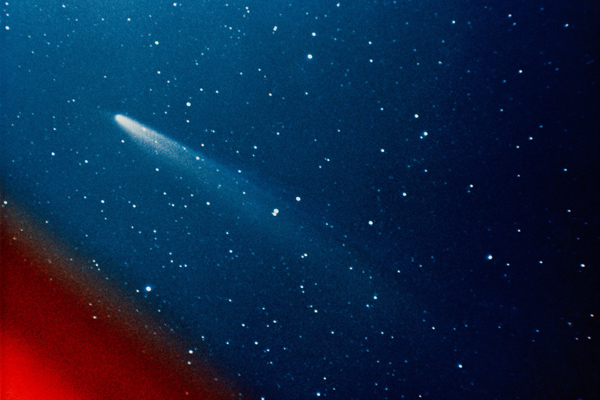 Comet Kohoutek / nasa.gov
Comet Kohoutek / nasa.govComets such as Kohoutek originated from the Oort Cloud and appears once every 75 thousand years or so, these type of comets are long period or non-periodic comets. Comets that come from the Oort cloud are typically "displaced" or "pushed" from their original place and shot off into the solar system. This can occur for many reasons such as the sun comes near another large star or even shock waves from a supernova. They are loosely tied to the sun and so it does not take much to knock them from their place and into an orbit about the sun.
Oort Cloud comets are much older then Kuiper comets but because of their point of origin, they do not approach the sun as often. As a result, they keep more of their ice and gases then does a Kuiper comet. This typically makes them brighter than Kuiper comets because they have more reflective material available. Such as Hale-Bopp, a long period comet that was the brightest comet to appear in the sky for 18 months in 1996 and its orbit is about every 4 thousand years.
Although these criteria are typical of a short or long period comet, that does not mean they can not change places. A long period comet can become a short period comet and vice versa because of tidal forces that can trap or change the orbit of a comet.
Parts of the Comet
There are 5 parts to a comet that can be viewed as it approaches the sun.
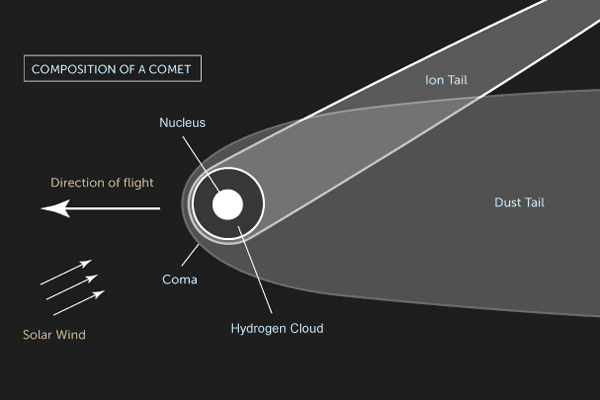 Composition of a comet / seti.org
Composition of a comet / seti.org- Nucleus: typically solid and mostly made of gases and ice with traces of dust and other solid materials such as rock. The nucleus is the "core" of the comet. Just think of it as a hunk of rock surrounded by frozen gases and water.
- Coma: a thick cloud comprised of water, carbon dioxide and other gases emitted by the nucleus that surrounds the nucleus. This is the first cloud layer of the comet that is not typically seen except during the first stages of the comets approach towards the sun. Basically, this is the "fog" of the comet.
- Hydrogen Cloud: a huge cloud that surrounds the comet which typically hides the interior of the comet. This is typically what you see when viewing a comet from Earth and is what makes the comet visible.
- Dust Tail: mostly tiny particles of dust that trail behind the comet. This is the "tail" of the comet when viewed. The tail can stretch for miles behind the comet and can contain bits of rocks and ice along with the dust particles.
- Ion Tail: mostly plasma laced with rays and streamers when interacting with solar winds, this part of the comet is not normally seen by the naked eye. A comparison to better understand the ion tail would be the "wake" of air left when a large object such as a car is in motion.
Discovery of Comets
A comet is pretty much invisible until it approaches the sun and the heat melts the ice that covers the comet. Only then can it be viewed, some even by the naked eye from Earth. Their orbits are eccentric (very wide orbits), so naturally it takes years for them to make their full rotation. The most famous of comets is Halley's comet which returns to be viewed from Earth, on average, every 75 to 76 years or so. The best time to view comets as they approach the sun would be either sunrise or sunset as this is when they are at their most visible from Earth. Light from the sun reflects off the "cloud" that surrounds the comet's nucleus making it like a bright ball in the sky.
Many scientists believe that Comets are what brought the elements needed to create life on Earth. Whether crashing into the planet's surface in Earth's beginning stages or by close flybys, it's suggested that comets brought water and other organic molecules to the planet. To prove this idea, a probe was landed on a comet called the Rosetta Mission in August of 2014. This probe observes and records data over the next 10 years to see if this theory is true.
Comets are typically named from the discoverer(s) of the comet. Some have short names such as Comet Halley, others have longer names such as Shoemaker-Levy. When a scientist or a group of scientist discover more than one comet, the comet is given a number at the end of their name to represent their order of discovery. For instance, Shoemaker-Levy 9 was the ninth comet that the Shoemakers and Levy discovered.
Most notable Comets
Here is a list of 15 of the most common periodic comets known. These comets average in size from 3 miles (5 km) to 10 miles (16 km). Three specific comets ( Borrelly, Wild 2, Churyumov-Gerasimenko) are the most notable as they have given us the most understanding about comets. Two probes (Deep Space 1 and Stardust) were able to get close to Borrelly and Wild 2 sending back large amounts of data for the scientist to study. Philae, the probe on Churyumov-Gerasimenko, is not due back until 2024.
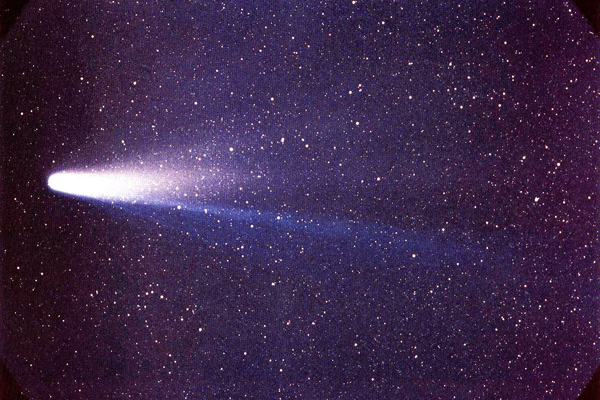 Halley's Comet / nasa.gov
Halley's Comet / nasa.govHalley's Comet — is probably the most famous of the comets. Seen every 75 to 76 years, its last passing was in 1989 and is not expected again until sometime in 2061. Halley's comet has been under observation since as early as 240 BC but it was not recognized as being the same comet until 1705. Astronomers believe that this comet originated in the Oort cloud on the far reaches of our solar system and is about 5 miles (8 km) wide and 10 miles (16 km) long.
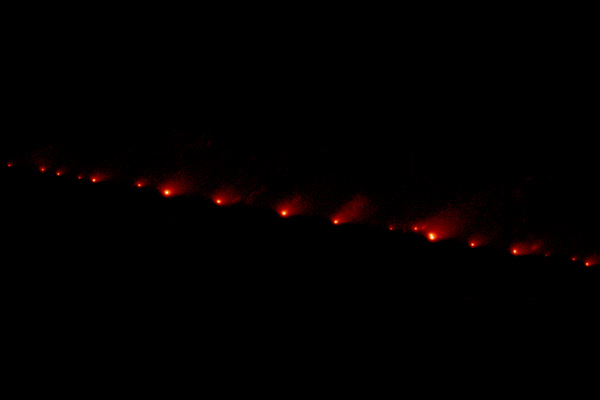 Shoemaker-Levy 9 / hubblesite.org
Shoemaker-Levy 9 / hubblesite.orgShoemaker Levy-9 — because it crashed into Jupiter in July of 1994, this comet no longer exist. This gave scientist the first observation of an actually celestial collision. For about 20 or 30 years, the comet remained in Jupiter's orbit before it finally crashed into the planet. This impact was about the equivalent of six million tons of TNT. It was the first comet discovered to be orbiting a planet and not the sun. The 9 in the name is because it is the 9th comet found by C. Shoemaker, E. Shoemaker, and Levy..
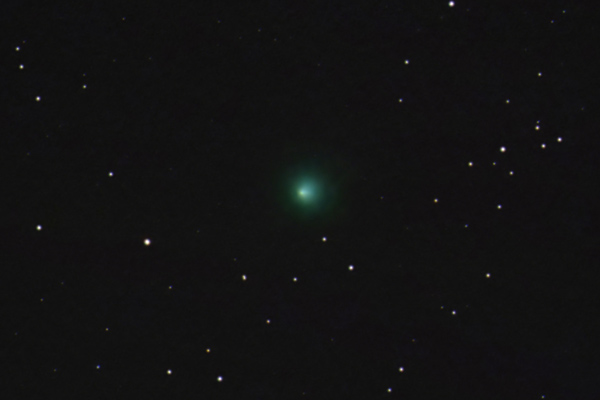 Encke / cajunastro.com
Encke / cajunastro.comEncke — completes its rotation around the sun about every 3.3 years. One interesting historical belief is that observations of the comet from a head on view made it appear in the shape of a swastika. It is about the time of the comet that this symbol began showing up in various cultures around the world and Encke might have been the catalyst for this. It is also responsible for the annual Taurid meteor showers in October and November.
 Hyakutake / nasa.gov
Hyakutake / nasa.govHyakutake — in January of 1996 Hyakutake came into view of Earth. Hyakutake was nicknamed The Great Comet of 1996 as it was clearly visible and was the closest any comet had approached Earth in 200 years. Due to its close approach observations of Hyakutake aided scientist in making several discoveries during its time in our skies.
 Hale-Bopp / sternwarte.at
Hale-Bopp / sternwarte.atHale-Bopp — Hyakutake may have come the closest to Earth in over 200 years, but Hale-Bopp was not to be upstaged. Hale-Bopp was the brightest comet in the sky for 18 months making it the longest to stay in our skies since 1811. It became visible to the naked eye in May of 1996 and is not expected to return again until the year 4385.
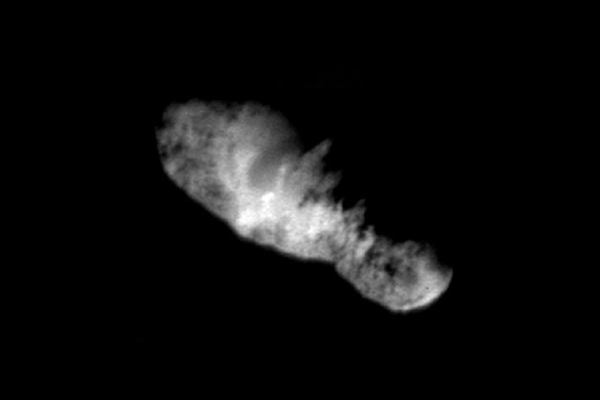 Borrelly Nucleus / nasa.gov
Borrelly Nucleus / nasa.govBorrelly — in 2001 Deep Space 1 got up close and personal with this comet and sent back images of its pitch-black core. These images also showed that its nucleus shape is like a bowling pin and was about 4 miles (8 km) long. Astronomers believe that this comet originated from the Kuiper Belt.
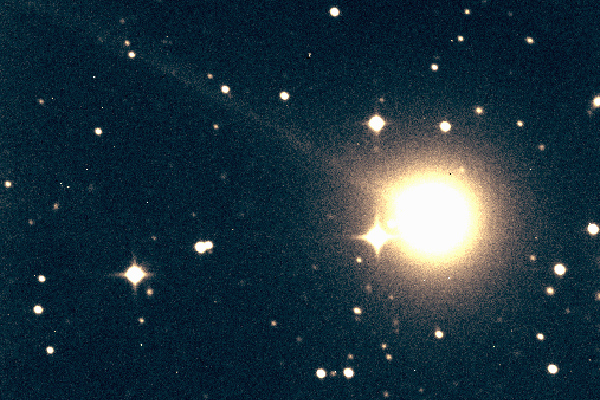 Tempel-Tuttle / nasa.gov
Tempel-Tuttle / nasa.govTempel-Tuttle — is responsible for the annual Leonid Meteor shower where thousands of streaks decorate the night sky around November. This is the result of Earth passing through the dust and rock left by Tempel-Tuttle as it races around the solar system. Interestingly enough, those "trails" are left over 100 years before Earth reaches it. For example, in 2002 we reached the trail that was left in 1767 and 1866.
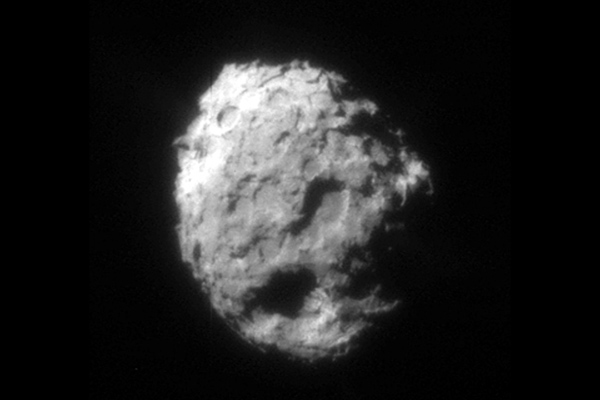 Wild 2 nucleus / nasa.gov
Wild 2 nucleus / nasa.govWild 2 — NASA's Stardust probe observed Wild 2 during a flyby in 2004 and sent back great images of its nucleus. It also collected the first samples of dust particles from the comets trail. Scientists believe that Wild 2 originated in the Kuiper belt and is about 3 miles (5 km) in size.
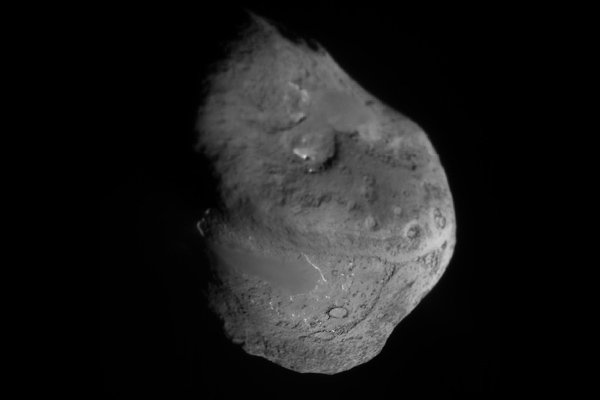 Tempel 1 nucleus / wikimedia.org
Tempel 1 nucleus / wikimedia.orgTempel 1 — back in 2005, Deep Impact (a spacecraft sent to "crash" into a comet), came into contact with Tempel 1. It created a crater the size of a football stadium though it was on the size of a washing machine. Its goal was to create a hole where details about the comet could be observed. Unfortunately, the idea worked a little too well and the images are too obscure to view. This comet orbits the sun every 5 to 6 years.
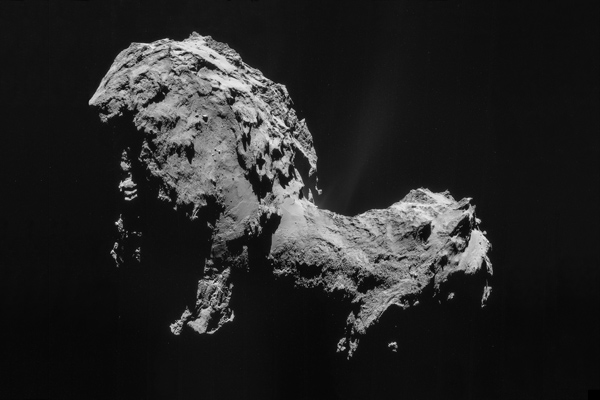 Comet Churyumov-Gerasimenko / esa.int
Comet Churyumov-Gerasimenko / esa.intChuryumov-Gerasimenko — back in 2004, the ESA (European Space Agency) sent a probe (Rosetta) to touch down on this comet when it came into view in 2014. This comet is about 3 miles (5 km) in size and completes its orbit around the sun every 6.6 years. Rosetta is to orbit the comet (nicknamed Chury) for a few months then release a lander called Philae on the comet's nucleus. It is due to return two years later (2016 or 2017) with information giving us a better understanding of the formation of our solar system.
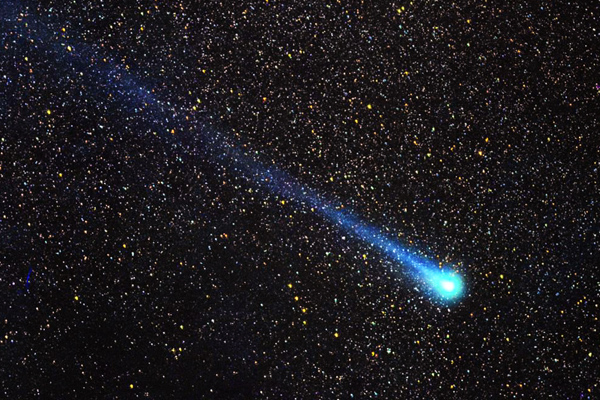 Swift-Tuttle / nasa.gov
Swift-Tuttle / nasa.govSwift-Tuttle — discovered by Lewis Swift and Horace Tuttle in 1862 and is responsible for the yearly Perseid meteor shower that occurs every July and August as Earth passes through the remnants of its tail. Its rotational period around the sun is about 120 years and it is believed by scientists that it could one day collide with Earth.
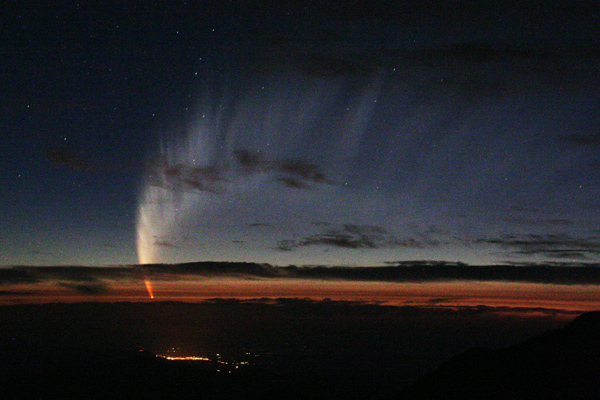 Comet McNaught from Cerro Pachon / gemini.edu
Comet McNaught from Cerro Pachon / gemini.eduMcNaught — was discovered very recently in 2007 and is a non-periodic comet and was the brightest seen comet from Earth since 1965. It's magnitude of -5.5 (the smaller the number the brighter the object) made it visible for 2 days from Earth's Northern hemisphere. The Ulysses Probe passed through McNaught's ion tail and sent back data showing a complex chemistry that still baffles scientist. The Solar Wind Ion Composition Spectrometer (SWICS) detected O3+ (positively charged oxygen atoms) which has never been found near a comet before.
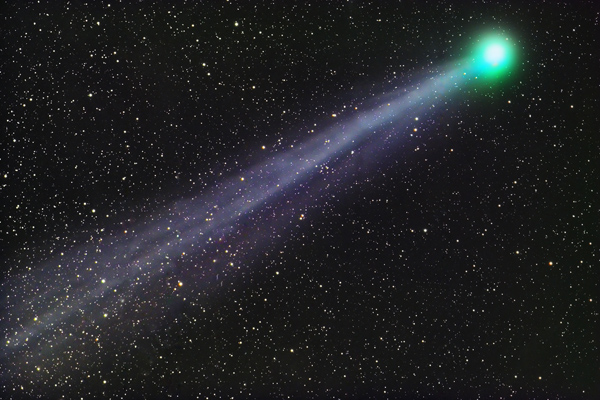 Comet Lovejoy / johnsastrophotos.com
Comet Lovejoy / johnsastrophotos.comLovejoy — discovered in 2011 by amateur astronomer Terry Lovejoy, is what they call a Kreutz Sungrazer. Kreutz Sungrazers are comets that pass extremely close to the sun and may have been a single comet that had broken up and became smaller comets. Lovejoy was visible during the Christmas holiday in 2011 and is nicknamed "the Great Christmas Comet".
Lexell — was not named after its discoverer but after Mathematician/Physicist/Astronomer Anders Johan Lexell. Lexell came the closest to Earth than any other comet in history at 1.4 million miles and has a nucleus about the size of Jupiter, as described by astronomer Charles Messier.
C/1843 D1 — is only known by its designation and nickname, the Great March Comet. This comet is another Kreutz Sungrazer that appeared in 1843 and had the longest amazing fan tail that stretched for two astronomical units (185 million miles) the only other comet recorded with a longer tail was Hyakutake's at almost 4 AU (371 million miles). This comet could be viewed from February of 1843 to April of 1843 and was bright enough to be seen from Earth during the day.
Video Gallery

-
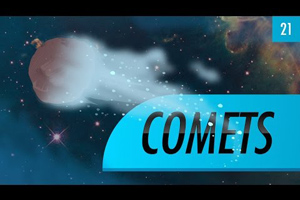 Comets: Crash Course Astronomy
Comets: Crash Course Astronomy
-
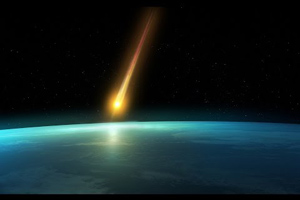 Facts And Mystery Of Comets
Facts And Mystery Of Comets
-
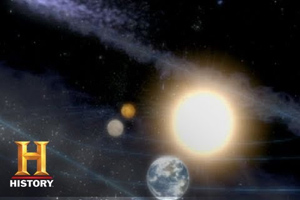 The Universe: Comets
The Universe: Comets